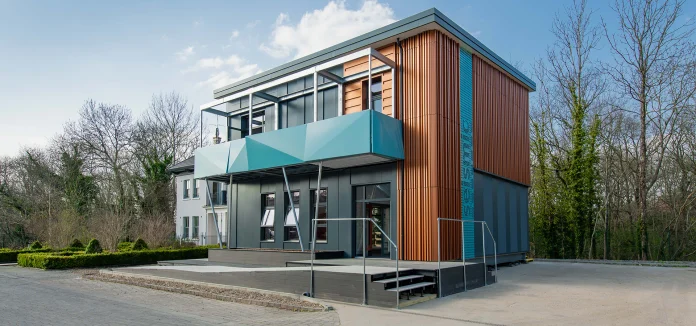Amid economic uncertainty and global turmoil, offsite construction is seemingly facing a bleak outlook. However, Mark Beirne of Cara EPS and a director of Offsite Alliance, argues that the crises besetting the sector can also prove a tipping point to go mainstream
To say we are in uncertain times might be considered an understatement. With the UK still adjusting to a post-Brexit world, a once-in-a-century event such as Covid, cost of living and fuel crises, labour and skills shortages, inflation at a 40-year high along with the highest interest rates in 15 years, impacts of climate change becoming more obvious each year and with at least high-profile two conflicts that are making the world seem a lot less secure, it could be said we are unprecedented times.
What does all this mean for the offsite industry, a sector that historically gets hit first and hardest by recessions and downturns in the economy? Offsite manufacturers, with fixed assets such as factories and equipment are particularly vulnerable to uncertain economic conditions.
On the surface, at least, this might seem to be evidenced by some high-profile closures of a number of prominent offsite manufacturers.
However, this is not telling the full story – especially considering that offsite manufacturers represent only a fraction of insolvencies.
“Never waste a good crisis”
Could it be that such a bleak picture actually presents the offsite sector with an opportunity to thrive, meeting the increasing and diverse needs of clients and as a result becoming ‘mainstream’?
Evidence suggests that the demand is certainly still there, irrespective of economic conditions. After all, the need for more social and affordable housing, prisons and school places won’t be going away anytime soon.
Mark Farmer’s Modernise or Die report in 2016 seems more apt than ever. Another, less talked about report, but one equally relevant in the current climate, is Andrew Wolthesthome’s 2010 report Never Waste a Good Crisis.
In many ways, there is reason for optimism for the offsite sector. The drivers for offsite detailed in Modernise or Die are even more acute.
For example, the skills shortage is deepening, and – for various reasons – won’t be solved easily or quickly.
Poor productivity continues to be a chronic issue, with offsite seen as a front-runner to address a problem that stifles growth and investment.
In response to traditional construction not being seen as fit for purpose to meet changing needs, the government sought to transform the industry by setting a number of ambitious key goals detailed in Construction 2025:
- 33% reduction in the initial cost of construction and whole life costs of built assets.
- 50% reduction in the overall time, from inception to completion of assets, for newbuild and refurbished assets.
- 50% reduction in greenhouse gas emissions in the built environment.
- 50% reduction in the trade gap between total exports and total imports for construction products and materials.
With industry trailing way behind these targets, could it be a reflection of the failure to mainstream offsite construction as intended?
What’s stopping the offsite sector from meeting these demands more fully?
A way in which clients could take the lead on this and benefit enormously to achieve these is by aggregating demand, procuring for value and taking a platform-based approach in scoping programmes of work.
We can’t expect clients to do this without good advice and this is where consultants, advisers and professional institutes play a vital role.
As an example of what can be achieved to solve problems around capacity, budget constraints and value, the Department of Education’s work over the 2015-2019 period bears revisiting:
Procured over £5bn through the Priority Schools Building Programme using National, Regional and Modular Frameworks, and achieved like-for-like savings of up to 35%, as high as 50% when area considerations are included.
Design costs reduced from 12% to 4%.
Much-reduced build programme times from 12 months for a typical 2FE primary school to four months, over 70% quicker.
Through progressive designs, continuous improvement and early contractor engagement, the department was able to build a healthy supply chain of factory-based manufacturers that were able to deliver to budget and quality, as well as building schools typically 50% and sometimes as much as 75% faster than previously used traditional methods.
This had a significant role in the government 2018 announcement that MMC would be its preferred approach and adopted offsite manufacturing across five of its departments.
Is offsite going to waste a perfectly good crisis by failing to modernise?
Demand is clearly present and it could be key to riding out the downturn.
Professor David Mosey CBE’s Constructing the Gold Standard is starting to drive better standards in procurement through an outcomes and value-based approach, with early adopters through client-led frameworks such as OSHA & CHIC, among others, as well as the government’s own framework body CCS, which has for a number of years adopted a mandatory FAC-1 collaborative form of contract to drive value.
The Construction Innovation Hub Value Toolkit is another huge step in the right direction, which can really help clients define and procure for value.
Is this the opportunity for the supply side to come together and offer a platform-based approach to mitigate potential capacity issues, as well as evolve with more interoperability?
Both of these, along with aggregated demand from demand side, could really drive efficiency and meet sensitive price points, particularly in social housing.
If this could be done, offsite uptake could be huge, which would drive more investment from supply side.
There are historical examples of supply side reacting quickly to potentially catastrophic events driving innovation to survive.
Anyone old enough to remember the CRINE initiative in the 70s North Sea oil and gas? The car and aerospace industries will understand – these sectors were on the verge of being wiped out in the UK, only for them to react positively to the threats, working together to meet price points and transform how they operate.
More recently, we all will remember how supply side reacted to Covid to offer solutions through collaboration and innovation, such as the rapid delivery of Nightingale hospitals.
Has offsite construction reached that tipping point yet?
The Offsite Alliance and Constructing Excellence are interested in speaking to anyone on how industry transformation can and does happen, why it matters and how you and your organisation can be a part of it.
Mark Beirne
Directo r
r
Offsite Alliance

















